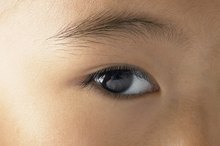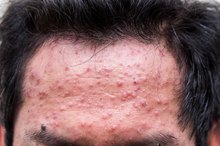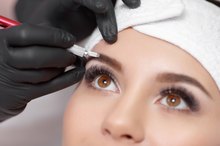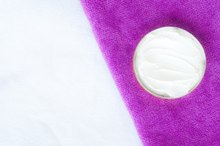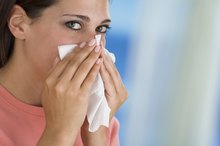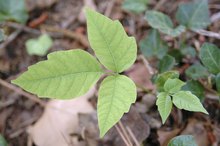Hair Loss Due to Rosacea
Rosacea is a common skin disorder that, according to the National Rosacea Society, affects more than 14 million Americans 1. Many people with rosacea go undiagnosed because of the low level of awareness; a Gallup survey recently found that 78 percent of Americans have now knowledge of the condition. Learning about rosacea also means learning about related conditions and complications, which can be more serious than rosacea itself.
Identification
Rosacea can be identified by redness anywhere on the face--either widespread or concentrated around the nose, cheeks, chin or forehead. Other symptoms include visible small blood vessels or bumps on the face, as well as watery or itchy eyes. Hair loss is typically not a symptom of rosacea alone, so hair loss on people with rosacea may indicate the presence of a related condition or complication of rosacea.
Seborrheic Dermatitis
What Are the Causes of a Sensitive & Painful Scalp?
Learn More
Seborrheic dermatitis is a condition that commonly has been found to occur among people who also have rosacea, although it also can occur independently. The severity of seborrheic dermatitis can vary from what appears to be mild dandruff to thick, scaly patches and severe itchiness. Severe cases of seborrheic dermatitis of the scalp also can be accompanied by hair loss.
Cause
The causes of rosacea and seborrheic dermatitis are unknown, although stress and weather changes often exacerbate the conditions. The cause of hair loss among people with rosacea and seborrheic dermatitis is the inflammation and itchiness of the scalp. Persistent scratching of the scaly and itchy patches can uproot hair follicles, resulting in temporary hair loss. The inflammation of the sebum glands also can affect the hair follicles and cause generalized hair loss.
- The causes of rosacea and seborrheic dermatitis are unknown, although stress and weather changes often exacerbate the conditions.
Social and Psychological Effects
Skin Problems That Cause Eyebrow Loss
Learn More
More than 76 percent of rosacea patients surveyed by the National Rosacea Society reported that the condition had lowered their self-esteem and self-confidence 1. The negative social and psychological affects of these skin conditions also may be increased when hair loss accompanies the redness or scaling of the skin and scalp, so identifying and treating the symptoms can help to restore quality of life for those affected.
Treatment
Hair loss due to rosacea and seborrheic dermatitis is temporary and reversible, and patients may recover fully once the inflammation of the scalp is treated. Rosacea is treatable with prescription topical medications and oral antibiotics. Seborrheic dermatitis can be treated with topical medications, including antifungal and steroid treatments, but topical steroids actually may cause steroid-induced rosacea in patients who are also treating symptoms of rosacea.
Lupus Erythematosus
Lupus erythematosus is an autoimmune disease that sometimes is mistaken for rosacea or seborrheic dermatitis because of the similarity of symptoms 3. Lupus erythematosus also causes scaly lesions on the skin or scalp, which get worse when exposed to sunlight, and rosy cheeks or widespread rash 3. About one-third of patients with lupus erythematosus experience temporary and reversible hair loss 3. They commonly have bald spots or brittle hair that breaks easily. In rare cases, the condition affects other organs and is potentially life-threatening, which is why seeing a doctor about rosacea-like symptoms and properly identifying whatever condition is causing the redness and hair loss is crucial.
Related Articles
References
- National Rosacea Society: What Is Rosacea?
- American Hair Loss Association: Infectious Agents
- Rosacea Guide: Lupus Erythematosus
- Al-balbeesi AO, Almukhadeb EA, Halawani MR, Bin saif GA, Al mansouri SM. Manifestations of ocular rosacea in females with dark skin types. Saudi J Ophthalmol. 2019;33(2):135-141.doi:10.1016/j.sjopt.2019.01.006
- Gallo RL, Granstein RD, Kang S, et al. Standard classification and pathophysiology of rosacea: The 2017 update by the National Rosacea Society Expert Committee. J Am Acad Dermatol. 2018;78(1):148-155.doi:10.1016/j.jaad.2017.08.037
- Han J, Liu T, Zhang M, Wang A. The relationship between inflammatory bowel disease and rosacea over the lifespan: A meta-analysis. Clin Res Hepatol Gastroenterol. 2019;43(4):497-502.doi:10.1016/j.clinre.2018.09.009
Writer Bio
Lesley Graybeal has been writing articles for internet content since 2006. Her work can be found on a range of hobby and business resource web publications, including Trails.com and Business.com, as well as several academic journals. Lesley earned her B.A. and M.A. degrees in English from the University of Georgia, and is currently completing her dissertation in Social Foundations of Education.

